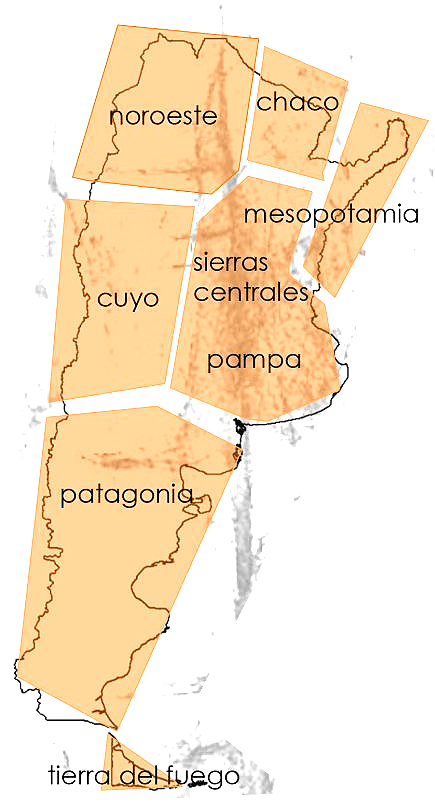Ethnia Memorial
“Ethnia” is a small tribute to the first inhabitants and original peoples of South America in the current Argentine territory.
It is known to all the consequences of the conquest of America in HISTORY.
Without a doubt, the forced intervention produced in the self-development of indigenous peoples, the dismemberment and almost annihilation of the local population and the irremediable loss of their rich cultures and customs do not have the weight of their tragedy in the balance of THAT history. Despite this genocide, the new American identity and culture began.
The creation and development of the new societies, peoples and nations that comprise it, are recent events that form the character, customs and behaviors of “Five centuries alike”, and that determine the realities of history that we continue to write all days.
With this simple MEMORIAL to the native peoples of the Argentine territory – a minimal sample of studies and works of great professionals and institutions – we try with some images and personal interpretations, to present another of the ORIGINS of our ARGENTINE ESSENCE. And with this in mind, we intend to incorporate new EXPLAIN into our FLAVOR MENU.
With the arrival of the Spanish conquerors in the 16th century, indigenous peoples saw their possibilities of developing their culture cut short. Only some managed to survive the changes that historical evolution imposed on them, but without a doubt they constitute a good part of the essence of the current Argentine population. To synthesize the complex panorama of the different cultural groups of the native peoples, they can be divided according to their habitat into indigenous peoples of the Northwest, Central Sierras, Cuyo, Pampa, Patagonia, Neuquén, Chaco, Litoral and Mesopotamia.
We will make a brief review of each group or town, with the “errors” of interpretation that this synthesis will cause. he history is much more complex and confusing, with the difficulty that the oral transmission of events and traditions entailed, and that in many cases are lost with the disappearance or miscegenation of the indigenous population. Added to this, the contempt and abandonment that the entire historical, social and economic environment professed for the indigenous peoples until a few decades ago, time from which they try to re-value their wealth and their deserved rights of existence.

diaguitas
current Argentine northwest
They lived in square-shaped houses made of stone and thatched roofs, and their villages were protected by pucarás or fortresses. current Argentine northwest They were relatives of the Incas but they fought against them, as they were excellent warriors, who fought on foot, with bows and arrows, protecting their chests with metal plates, which they themselves made. They also resisted, although without final success, the Spanish domination, but their resistance lasted a hundred years. They stood out in agriculture for their cultivation terraces, similar to those of the Incas, and used irrigation systems. Their basic diet consisted of corn, quinoa, beans and squash. They were weavers, using vicuñas, llamas and guanacos wool and cotton as raw material. They were also excellent potters and workers in metals such as silver, copper, and gold. They divided into groups, ruled by caciques, with power transmitted by inheritance, which did not have political unity, although they were unified by a common language that was Kakana. They lavished cults on natural phenomena such as the sun, lightning, and thunder, and those in charge of the cult were magicians or sorcerers. They believed that the human soul was immortal and transformed into a star. They also worshiped Mother Earth or Pachamama.
tobas
current chaco and formosa
Until the 19th century, they were a predominantly semi-nomadic hunter-gatherer people that marched in search of their food resources and there was a strong sexual division of labor among them: men from a very early age dedicated themselves to hunting and fishing and women to harvesting and an incipient horticultural agriculture largely influenced by Andean contributions and amazonids. In this way, in small plots they cultivated nachitek (squash), oltañi (corn), avagha (beans), sweet potatoes, cassava, etc. However, such crops were only complementary to their diet and did not have surpluses to accumulate food of agricultural origin. There is an ecological explanation for this apparent backwardness: the climate and the edaphology of its territory did not allow enough yields for its agricultural productions, while the Chaco territory in the wild was a great source of food resources, especially of first quality proteins. The Qom mainly hunted tapirs, peccaries, guanacos, and large numbers of birds.
As a complement they used to collect honey and a large amount of fruits, berries and wild roots.
huarpes
current whose and la rioja
Each tribe was made up of about 30 people distributed in 6 or 7 houses that were commanded by a cacique. It can be said that they were relatively sedentary, although it is important to mention that those groups that lived on fishing and agriculture were clinging to the land. They hunted guanacos, rheas, and other small animals to get their food. They kept the meat charqueada, that is to say dried in the sun, by lake time. They also collected rhea eggs and chañar and carob fruits. The carob was very important in its diet; They kept it in pots, ground it and made the patay, a kind of bread, with the flour obtained. Also with the carob pods they prepared fermented drinks such as añapa. The groups that lived near the Guanacache lagoons fished for catfish and trout and hunted wild ducks. To fish they used rafts, four or five meters long, which they also used for transportation. They practiced all kinds of economy for subsistence: agriculture, hunting, fishing and gathering.
guaranies
Current mesopotamia and paraguay
They retain an eminently agricultural tradition, and are not assimilable to nomadic society. They implement rules for distribution and redistribution of the means of production and products, as well as collaboration, built on family ties. Agricultural techniques consist of cultivation in medium and small plots suitable for the production of personal consumption (the Kokue), rarely exceeding three hectares. The grounds are cleaned, if necessary, with the use of fire, and prepared to plant the seeds; remaining fit for use for several years, after which they are then left to “rest” until they are ready for new use. The grounds are cleaned, if necessary, with the use of fire, and prepared to plant the seeds; remaining fit for use for several years, after which they are then left to “rest” until they are ready for new use. They have a refined botanical taxonomy, which allows them to obtain optimal results in the agricultural field in the cost-benefit ratio and in the management of soils and polycultivates (different species alternated on the same land). A peculiarity of the Guaraní language is that after Latin it is the one that has been most used in the cataloging of flora and fauna. The aborigine was a great connoisseur of their habitat, which favored naturalists when cataloging flora and fauna.
pampas
Current pampa húmeda
Originally they were hunters of deer, rheas and guanacos. Originally they were hunters of deer, rheas and guanacos. They were also gatherers of wild fruits and seeds, which they ground to make flour. The pampas were tall, elongated head, and had a certain resemblance to the Patagonians, although they were somewhat smaller in stature. The skeleton found at Fontezuelas is believed to have preceded even the historical pampas; the same has been said of the fossil skulls of Arrecifes. They used the bow and arrow, hunted deer on foot, and rendered them tired. They were nomads, their home consisted of a simple windshield, with painted and marinated deer leathers, later they used bovine and equine leathers. Surely the pampas awning was a further improvement. Their food was meat; They collected wild products of plant or animal origin and, like all Patagonian peoples, they dressed in a pampanilla and a pellón, the chillango that served as their cape. They worked the stone and owned large lithic mortars, they used two-ball rounders and also one. In the area occupied by the Querandíes, a pottery with simple, engraved and geometric decoration has been found, which was possibly their own.
By adopting the horse, they abandoned what had been, at first, their activity as potters, increased nomadism, and then intensely practiced the art of basketry.
tehuelches
Current patagonia
The Tehueches or Patagonians, were nomadic pedestrian tribes, hunter-gatherers who traveled through the steppes of Patagonia in search of animals to hunt and feed. Before they knew the horse, they made long journeys on foot, but when the Europeans brought this animal, they became skillful riders, adopted them as means of transportation, and became equestrian nomads. It is said that when the first expedition of Hernando de Magallanes arrived, in 1520, there was a meeting between a European and a southern aborigine, who is described as a tall, corpulent man with very large feet. From there would also come the name of Patagones. His average height was 1.80 m. Men and women were stocky, broad-shouldered, with a large face, thick lips, a short, wide nose, and small, dark eyes. They had coppery skin, straight black hair, shoulder length. They painted their faces red, black and yellow, covering it with lines in a mixture of grease and earth. In addition, sometimes the face or arms were tattooed with fine cuts on the skin that were later stained with ash and colored earth.
In the seventeenth and early nineteenth centuries, the population that until then dominated this immense territory began to disappear, being replaced by another of different characters and of Araucana or Mapuche ancestry, coming from Chile with their language, customs and beliefs.
onas
Current Tierra del Fuego
The onas lived on the large island of Tierra del Fuego, where they hunted guanacos and harpooned. They used fire. Their huts were for winds. They wore sewn guanaco fur cloaks, moccasins, and leather leggings. They wore snail necklaces and painted their horn. Elders and sorcerers acted as chiefs. Monogamy was predominant. They believed in a supreme god (Temaukel) and the creator hero. The onas were tall, had copper skin, small oblique eyes, and abundant black hair. His house was a simple leather raised as a screen, in semicircles, or a conical hut of sticks. They covered themselves with guanaco or other animal skin, with their hair hanging out. Their main food was guanacos, tucu-tucus and sea lions. They collected shellfish, food roots and fungi, and from the seed of a cruciferous, the tai, they obtained a flour with which they made a paste that was part of their nutrition
He practiced basketry, they lacked musical instruments, but they sang and celebrated ceremonies. The family was originally monogamous, but there was also polygamy. There were no caciques, but the opinion of the elders was respected, especially the sorcerers
“Each person shines with his own light among all the others. There are not two equal fires. There are big fires and small fires, and fires of all colors. There are people with serene fire who don’t even know about the wind, and people with crazy fire that fill the air with sparks. Some fires, foolish fires, do not light or burn; but others burn life with such desire that you cannot look at them without blinking, and whoever comes closer lights up.”
Eduardo Galeano, diversity

